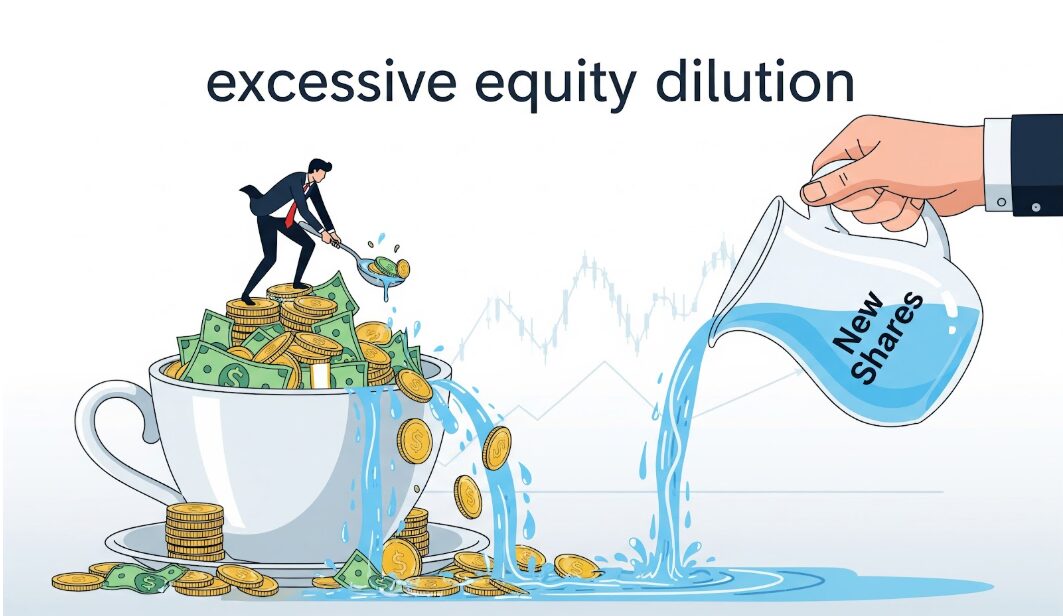How would you secure your company from excessive equity dilution? Before diving into strategies to prevent dilution, it’s important to emphasize that many first-time founders underestimate its impact.
Accepting capital from formal or informal investors inherently means agreeing to specific terms and conditions that can significantly affect ownership.
Examining the fine print and reading between the lines before accepting the term sheet can prevent issues later. Always retain the services of an expert fundraising consultant who can help you navigate the intricacies of raising capital. You’ll particularly look out for the ownership percentage involved.
Investors may not require an ownership stake right away, especially when the startup is in its nascent stages. Instead, they’ll defer claiming shares in lieu of the capital they’re offering. For instance, they may require shares when you raise funding at the seed stage or Series A stage.
The number of shares and the ownership percentage may be small and easily achievable at the outset. Founders often think that this provision won’t really impact their stake or control rights over the company. But each successive fundraising round and the shares you offer have an impact.
You might find that your ownership percentage is steadily depleting to a point where you lose control over decision-making. Founders often realize too late that third parties hold a controlling stake. As a result, they successfully oust the owner/founder from their own company.
Don’t let that happen to you. Understand how to secure your company from excessive equity dilution. Approach each fundraising round cautiously and weigh your options before seeking external capital. Here’s what you can do to ensure that you have a lucrative exit–at your terms.

*FREE DOWNLOAD*
The Ultimate Guide To Pitch Decks
Delay Raising Funding from External Sources
When building the startup, rely on your personal funds and savings and bootstrap to achieve its early milestones. At this time, your focus should be on adopting a lean approach and growing the business organically. When you do reach out to investors, they will appreciate capital efficiency.
Founders who have skin in the game are a big draw for investors. Delaying fundraising also means relying on existing revenue streams and reinvesting those funds in the company. You’ll validate the business idea and demonstrate its profit-earning potential.
These metrics lend weight to the pitch deck’s financials. Not only will you find it easier to raise capital, but you can also negotiate for better terms and conditions. A lower risk factor translates into cheaper capital, and investors may be open to accepting a smaller equity stake.
Many advisors warn that raising institutional capital too early often means founders give away a larger-than-necessary share of equity For example, early rounds usually involve ~20 % equity dilution, which you can avoid with strategic planning.
Consider Tapping Non-Dilutive Sources of Capital
As you progress to the pre-seed stage of the startup, you may need money to continue building. At this time, you’ll consider approaching friends and family, and non-dilutive funding sources. Consider lenders who won’t require an equity stake in the company in exchange for the capital they provide.
You’ll also leverage the various small-business incentives and credits offered by the state and federal governments. Do your research into their approval criteria, which can include the intellectual property (IP) you’ve developed, for example. Also, look for the grants available to startups in your sector.
Here are a few options to check out:
- Small Business Innovation Research (SBIR) and Small Business Technology Transfer (STTR) Programs – The federal government offers grants to early-stage startups for research and development (R&D), but does not require equity.
- National Science Foundation “America’s Seed Fund” – This organization offers up to $2M in non-equity funding for tech startups.
- National Institutes of Health Small Business Programs – The NIH offers over US$1.4B annually in non-dilutive funding for life-science startups via SBIR/STTR.
- Research & Development Tax Credits – Although this is not a “funding grant,” it’s a non-equity incentive for startups investing in R&D.
- Grants from foundations or NGOs target startups in the climate, health, and impact sectors.
- Corporate Innovation Funds like Google for Startups, AWS Activate, and Microsoft for Startups often provide credits, grants, or co-development opportunities.
- The Small Business Administration (SBA) offers low-interest loans for small businesses.
- Crowdfunding platforms, accelerators, and incubator programs are other sources.
- Venture debt and revenue-based financing can also give your startup that non-dilutive boost.
- R&D Tax Credits are refundable credits available to startups investing in innovation and concepts that can transform the industry.

Raise Capital Smarter, Not Harder
- AI Investor Matching: Get instantly connected with the right investors
- Pitch & Financial Model Tools: Sharpen your story with battle-tested frameworks
- Proven Results: Founders are closing 3× faster using StartupFundraising.com
Maintain a Minimum Cash Burn
As seasoned entrepreneurs advise, adopting a lean approach to building the company should be integral to your operating practices. You’ll secure your company from excessive equity dilution by keeping costs down, both before and after raising capital.
Cost efficiency means you have more cash available, reducing your reliance on external financing. You’ll stretch every dollar and make it work. Also, minimize your cash burn and experiment with the minimum viable product (MVP) at every step. Test it on real users and incorporate the feedback.
This approach will be a robust cornerstone for building a sustainable business. Lowering costs also means the company will have a stronger bottom line — an impressive metric in your pitch. Expect investors to readily offer funding at favorable terms, including a lower equity stake.
Strategize Your Fundraising
When the company is ready for an infusion of capital, carefully strategize the round with the advice of expert consultants. They will assist by creating models of various capital frameworks to understand and anticipate the round’s long-term impact.
Using AI-powered tools, you’ll calculate how instruments like convertible notes and Simple Agreement for Future Equity convert into equity. Accordingly, you can negotiate for terms that won’t involve giving up a larger ownership stake.
If you do intend to raise capital using convertible notes and SAFEs restrict the amount raised to small sums. Further, you’ll convert them into equity as soon as you raise the next funding round. Strategies like these will maintain clarity in the cap table, which is a crucial aspect investors expect to see.
Moreover, founders often make the mistake of relying on these instruments since they don’t need to make payments right away. However, they usually overlook the valuation cap and discounted rates investors can claim when converting them into stock.
Warrants are yet another financial instrument that founders use to raise funding. Investors purchasing warrants have the option to buy a specific number of shares within a pre-determined time frame and price. Investors can exercise their right to acquire additional equity, diluting the founders’ ownership.
Issuing too many warrants can destabilize the cap table. You also risk triggering a conflict of interest between the owners, investors, and employees. Be cautious when issuing warrants.
Calculate the Capital You Absolutely Need
To secure your company from excessive equity dilution, calculate the capital you absolutely need before starting the round. This process will require detailed planning to raise enough money to reach the startup’s next milestones. Raising too little means you run out of funding too early.
This shortfall reflects ineffective leadership and poor judgment, which investors perceive negatively. You’ll find it harder to raise capital to cover the shortfall. On the other hand, raising an inordinately large sum of money translates into giving up more equity than necessary.
You’ll work to create an optimal balance that increases the company’s valuation and ensures better terms in the next round. Lowering the risk of a down round is another advantage.
Keep in mind that storytelling is everything in fundraising. In this regard, for a winning pitch deck to help you here, take a look at the template created by Peter Thiel, Silicon Valley legend (see it here) that I recently covered. Thiel was the first angel investor in Facebook with a $500K check that turned into more than $1 billion in cash.
Remember to unlock the pitch deck template that founders worldwide are using to raise millions below.
Create the Employee Option Pool Strategically
Creating an employee option pool is a strategic decision that helps you attract top-tier talent to the startup. However, use a tactical approach when setting aside equity for employees to avoid diluting the owners’ equity.
This means factoring in the potential dilution from other financing instruments you may have issued. Further, investors may insist on your creating or expanding the pool at later-stage founding rounds. Accept their conditions cautiously because you’ll end up diluting your ownership stake.
You’ll find the sweet spot between ensuring a motivated team backed by a competitive equity stake and avoiding equity dilution. Align the pool with your company’s needs and anticipated future hiring. You can always refresh the option pool as the team grows.
Create and Consistently Update the Cap Table
Create a detailed cap table that presents a clear picture of the company’s ownership structure at a glance. Ensure that this framework is clear, accurate, transparent, and well-organized. You’ll also update it from time to time, ideally after each successful fundraising round and other financing event.
Not only can you make well-informed decisions for raising capital, but prospective investors will also ask to see it. Remember that not having one is a red flag that prompts investors to walk away. More importantly, you’ll use the table to track the company’s ownership structure.
Using AI-powered tools, you can run funding simulations to understand how different models are likely to affect your ownership stake. This software can also assist in valuing the company, ensuring that equity transactions are appropriately documented to avoid conflicts.
When sharing equity between the co-founders, you’ll allocate shares according to their contributions and roles in the company. Equity does not need to be shared equally. Also, remember to include vesting schedules for not just the employees but also the co-founders.
Don’t forget to clearly define exit pathways and what happens to a co-founder’s equity should they choose to leave.
An essential aspect of preventing excessive dilution is understanding exactly how rounds of financing work for startups. You’ll have a better handle on negotiating with investors. Check out this video in which I have explained what you need to know.
Select the Right Investors
Selecting the right investors is the best way to secure your company from excessive equity dilution. You’re looking for investors who are interested in more than just profit sharing and a lucrative exit. You need potential strategic partners who provide a lot more than just capital.
Their objectives center around scaling the company exponentially with value-driving inputs and added resources. Think industry-specific expertise, networking opportunities within their list of contacts, recommendations of top talent, and participation in follow-on funding rounds.
Such investors are unlikely to demand a controlling stake that can erode founder autonomy but will assist in increasing valuation. Their ultimate goal is to select viable ideas and founders and nurture them to build the next unicorn.
Be wary of entities who require super pro-rata voting rights and unfair preferential treatment. Or, any other terms that deter other investors from providing you with capital. You’ll vet investors carefully paying special attention to their investment horizons and expected returns.
Those that intend to divest their holdings in a short time are best avoided. They could sell their stake to unknown third parties, which raises your risk of unexpected dilution.
Don’t Hesitate to Negotiate Terms Aggressively
If you want to secure your company from excessive equity dilution, don’t hesitate to negotiate the valuation aggressively. Scrutinize the term sheet carefully, particularly provisions like preferred shares, anti-dilution clauses, pro-rata voting rights, and liquidation preference.
Ensure that you understand the impact of these clauses on your ownership stake. Not just at present but also at the time of an exit through a merger or acquisition or an initial public offering (IPO). Remember that the terms you agree to now can set a precedent for future funding rounds.
Also, look out for terms that entitle investors to disproportionate payouts. At the same time, be open to risk-mitigation provisions investors may require like, for example, during a down round. You can negotiate adjusting the conversion price and offering a weighted-average anti-dilution in lieu of full-ratchet.
How to Secure Your Company from Excessive Equity Dilution
With the assistance of your expert fundraising consultant, you’ll take several steps to avoid dilution. For instance, you’ll issue super-voting shares to the co-founders. You’ll also institute provisions in the articles of incorporation to secure the board’s control over the company’s decision-making.
Your primary focus at this time should be on the long-term success and scalability of the company. Preserve as much equity as possible at every funding round. Negotiate for terms and conditions that are fair to the company and founder and not just investor-friendly.
Most importantly, don’t hesitate to scout around the market for other sources of capital. You don’t need to accept the first term sheet that is offered to you. Make sure that the investors and their terms align with the company’s future goals and your vision and mission statement. Select strategic investors/partners with whom you can trust and work well.
You may also find our free library of business templates interesting. There, you will find every single template you need to build and scale your business completely, all for free. see it here.





Facebook Comments